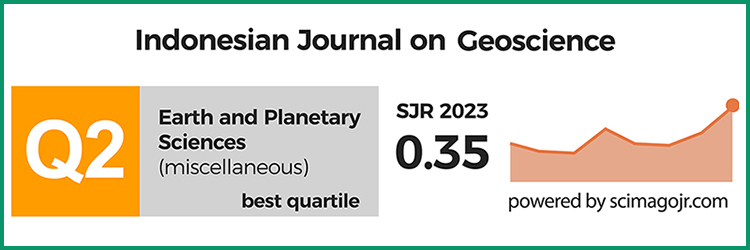Estimated Emplacement Temperatures for a Pyroclastic Deposits from the Sundoro Volcano, Indonesia, using Charcoal Reflectance Analyses
DOI:
https://doi.org/10.17014/ijog.5.1.1-11Keywords:
Liyangan archeological site, charcoal, Sundoro Volcano, pyroclastic flow deposition temperatureAbstract
References
Aldrian E., 2000. Pola Hujan Rata-Rata Bulanan Wilayah Indonesia; Tinjauan Hasil Kontur Data Penakar Dengan Resolusi Echam T-42. Jurnal Sains dan Teknologi Modifikasi Cuaca, 1 (2), p.113-123.
Ascough, P.L., Bird, M.I., Scott, A.C., Collinson, M.E., Cohen-Ofri, I., Snape, C.E., and Le Manquais, K., 2010. Charcoal Reflectance Measurements: Implications for Structural Characterization and Assessment of Diagenetic Alteration. Journal of Archeological Science, 37(7), p.1590-1599. DOI: 10.1016/j.jas.2010.01.020.
Australian Standard (AS) 2856, 1986. Coal Maceral Analysis.
Carrichi, C., Vona, A., Corrado, S., Giordano, G., and Romano, C., 2014. 79AD Vesuvius PDC Deposits’ Temperature Inferred from Optical Analysis on Woods Charred In-Situ in The Villa dei Papiri at Herculaneum (Italy). Journal of Volcanology and Geothermal Research, 289, p.14-25. DOI: 10.1016/j.jvolgeores.2014.10.016.
Giordano, G., Porreca, M., Musacchio, P., and Mattei, M., 2008. The Holocene Secche d Lazaro Phreatomagmatic Succession (Stromboli, Italy). Evidence of Pyroclastic Density Current Origin Deduced by Facies Analysis and AMS Flow Directions. Bulletin of Volcanology, 70, p.1221. DOI: 10.1007/s00445-008-0198-x.
Gurioli, L., Pareschi, M.T., Zanella, E., Lanza, R., Deluca, E., and Bisson, M., 2005. Interaction of PyroclasticDensity Currents with Human Settlements: Evidence from Ancient Pompeii. Geology, 33 (6), p.441-444, DOI: 10.1130/G21294.1.
Inoue, J. and Yoshikawa, S., 2003. Identification of Charcoal in Quaternary Sediments and Estimation of the Charred Temperature by Reflectance Measurements and H/C RatioAnalysis and Observation through Reflectance and Scanning Electron Microscopy. Journal of Geoscience, 46 (8), p.127-134.
Jones, T.P., Scott, A.C., and Cope, M., 1991. Reflectance measurements and the temperature of formation of modern charcoals and implications for studies of fusain. Bulletin de la Société Géologique de France, 162, p.193-200.
Kusumadinata, K., Hadian, R., Hamidi, S., and Reksowirogo, L.D., 1979. Data Dasar Gunung Api Indonesia, Bandung, Direktorat Vulkanologi, 820pp.
Porreca, M., Mattel, M., MacNiocaill, C., Giordano, G., McClelland, E., and Funiciello, R., 2007. Paleomagnetic Evidence for Low-Temperature Emplacement of the Phreatomagmatic Peperino Albano Ignimbrite (Colli Albani Volcano, Central Italy). Bulletin of Volcanology, 70, p.877-893. DOI:10.1007/s00445-007-0176-8.
Prambada, O., Arakawa, Y., Ikehata, K., Furukawa, R., Takada, A., Wibowo, H.E., Mitsuhiro, N., and Kartadinata, M.N., 2016. Eruptive History of Sundoro Volcano, Central Java, Indonesia since 34 ka. Bulletin of Volcanology, 78, p.81. DOI:10.1007/s00445-016-1079-3.
Sawada, Y., Sampei, Y., Hyodo, M., Yogami, T., and Fukue, M., 2000. Estimation of Emplacement Temperatures of Pyroclastic Flows Using H/C Ratios of Carbonized Wood. Journal of Volcanology and Geothermal Research, 104, p.1-2. DOI:10.1016/S0377-0273(00)00196-7.
Scott, A.C., 2000. The Pre-Quaternary history of fire. Journal of Palaeogeography, Palaeoclimatology, Palaeoecology, 164 (1-4), p.281-329. DOI:10.1016/S0031-0182(00)00192-9.
Scott, A.C. and Damblon, F., 2010. Charcoal: Taphonomy and Significance in Geology, Botany, and Archaeology. Journal of Palaeogeography, Palaeoclimatology, and Palaeoecology, 291 (1-2), p.1-10. DOI: 10.1016/j.palaeo.2010.03.044.
Scott, A.C. and Glasspool, I.J., 2005. Charcoal Reflectance as a Proxy for the Emplacement Temperature of Pyroclastic Flow Deposits. Journal of Geology, 33, p.589-592. DOI:10.1130/G21474.1.
Scott, A.C. and Glasspool, I.J., 2006. Observations and Experiments on The Origin and Formation of Inertinite Group Macerals. International Journal of Coal Geology, 70 (1-3),p.53-66. DOI:10.1016/j.coal.2006.02.009.
Setijadji, L.D., 2010. Segmented Volcanic Arc and its Association with Geothermal Fields in Java Island, Indonesia. Proceedings of World Geothermal Congress 2010, Bali, Indonesia.
Sulpizio, R., Dellino, P., Doronzo, D.M., and Sarocci D., 2014. Pyroclastic Density Currents: State of the Art and Perspectives. Journal of Volcanology and Geothermal Research, 283, p.36-65. DOI: 10.1016/j.jvolgeores.2014.06.014.
Tim Penelitian Balai Arkeologi Yogyakarta, 2012. Laporan Penelitian Arkeologi Situs Liyangan, Temanggung, Jawa Tengah, Yogyakarta. Balai Arkeologi Yogyakarta (unpublished).



















